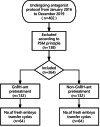Effect of GnRH antagonist pretreatment before controlled ovarian stimulation in antagonist protocol for infertile women with PCOS undergoing IVF/ICSI: A propensity score matching analysis
- PMID: 40587739
- PMCID: PMC12212814
- DOI: 10.1097/MD.0000000000042965
Effect of GnRH antagonist pretreatment before controlled ovarian stimulation in antagonist protocol for infertile women with PCOS undergoing IVF/ICSI: A propensity score matching analysis
Abstract
This retrospective cohort study evaluates the clinical effects of an antagonist protocol on in vitro fertilization and intracytoplasmic sperm injection among infertile women with polycystic ovary syndrome. A propensity score matching analysis was conducted of 402 infertile women diagnosed with polycystic ovary syndrome undergoing in vitro fertilization/intracytoplasmic sperm injection cycles. The patients were divided into 2 groups: GnRH antagonist (GnRH-ant) pretreatment protocol (n = 202) and non-pretreatment protocol (n = 200). The primary outcome was the high-quality embryo rate. The metaphase II (MII) oocyte rate was calculated. After adjusting for confounders, the high-quality embryo rate (48.29% vs 42.74%, P = .010) was found to be significantly higher in the pretreatment group. However, the number of retrieved oocytes (12.00 vs 12.00, P = .878), the MII oocyte rate (76.6% vs 76.0%, P = .663), the incidence of ovarian hyperstimulation syndrome (6.82% vs 2.27%, P > .05), and the cycle cancelation rate (51.52% vs 51.52%, P > .05) were not significantly different between the 2 groups. Similar results were obtained in the propensity score matching analysis of live birth rate (LBR, 46.88% vs 40.63%, P = .476). GnRH-ant pretreatment protocol resulted in increased high-quality embryo rates without increasing the cycle cancelation rate and the incidence of ovarian hyperstimulation syndrome. The number of retrieved oocytes, the MII oocyte rate, and the clinical pregnancy outcomes did not differ after GnRH-ant pretreatment.
Keywords: PCOS; PSM; antagonist protocol; embryo quality; pretreatment.
Copyright © 2025 the Author(s). Published by Wolters Kluwer Health, Inc.
Conflict of interest statement
The authors have no conflicts of interest to disclose.
Figures




Similar articles
-
Oral medications including clomiphene citrate or aromatase inhibitors with gonadotropins for controlled ovarian stimulation in women undergoing in vitro fertilisation.Cochrane Database Syst Rev. 2017 Nov 2;11(11):CD008528. doi: 10.1002/14651858.CD008528.pub3. Cochrane Database Syst Rev. 2017. PMID: 29096046 Free PMC article.
-
Shorter ovarian stimulation is detrimental to fresh embryo transfer outcomes in PCOS women undergoing GnRH antagonist protocol: a retrospective cohort study.Sci Rep. 2025 Jul 1;15(1):21002. doi: 10.1038/s41598-025-06217-0. Sci Rep. 2025. PMID: 40594896 Free PMC article.
-
Oral contraceptive pill, progestogen or oestrogen pretreatment for ovarian stimulation protocols for women undergoing assisted reproductive techniques.Cochrane Database Syst Rev. 2017 May 25;5(5):CD006109. doi: 10.1002/14651858.CD006109.pub3. Cochrane Database Syst Rev. 2017. PMID: 28540977 Free PMC article.
-
A repeated gonadotropin-releasing hormone agonist trigger improves pregnancy outcomes of frozen-thawed embryo transfer in GnRH antagonist cycles: a retrospective propensity-matched score analysis.J Assist Reprod Genet. 2024 Dec;41(12):3433-3443. doi: 10.1007/s10815-024-03269-5. Epub 2024 Nov 2. J Assist Reprod Genet. 2024. PMID: 39487904
-
Gonadotropin-releasing hormone agonist versus HCG for oocyte triggering in antagonist assisted reproductive technology cycles.Cochrane Database Syst Rev. 2011 Jan 19;(1):CD008046. doi: 10.1002/14651858.CD008046.pub3. Cochrane Database Syst Rev. 2011. Update in: Cochrane Database Syst Rev. 2014 Oct 31;(10):CD008046. doi: 10.1002/14651858.CD008046.pub4. PMID: 21249699 Updated.
References
-
- Porter RN, Smith W, Craft IL, Abdulwahid NA, Jacobs HS. Induction of ovulation for in-vitro fertilisation using buserelin and gonadotropins. Lancet. 1984;2:1284–5. - PubMed
-
- Trenkić M, Popović J, Kopitović V, Bjelica A, Živadinović R, Pop-Trajković S. Flexible GnRH antagonist protocol vs. long GnRH agonist protocol in patients with polycystic ovary syndrome treated for IVF: comparison of clinical outcome and embryo quality. Ginekol Pol. 2016;87:265–70. - PubMed
-
- Zhang Y, Li R, Qiao J. 2023 update on PCOS management: from diagnosis to long-term outcomes. Hum Reprod Update. 2023;29:257–79.
-
- European Society for Human Reproduction and Embryology. ESHRE guideline: ovarian stimulation in PCOS (2024 revision). Hum Reprod Open. 2024;2024:hoae025.
Publication types
MeSH terms
Substances
Grants and funding
LinkOut - more resources
Full Text Sources
Medical
Miscellaneous

